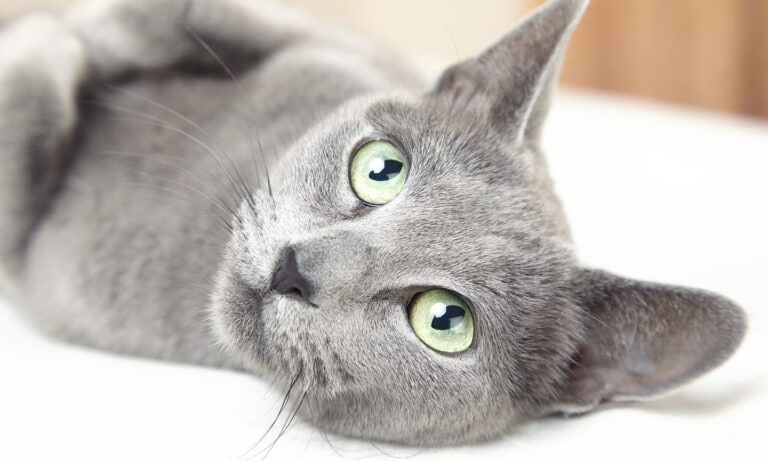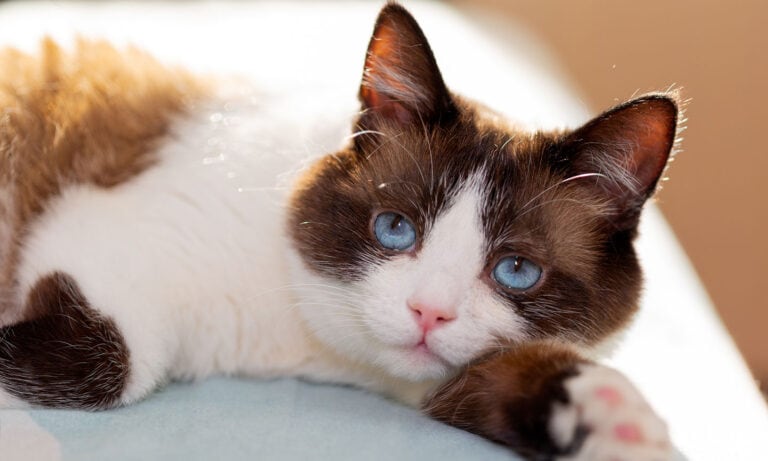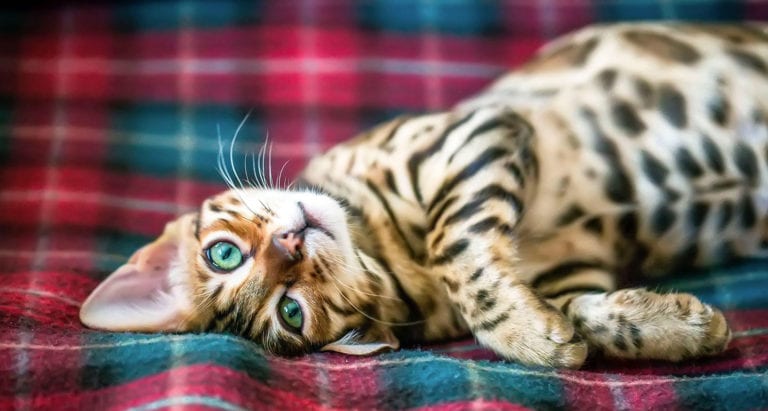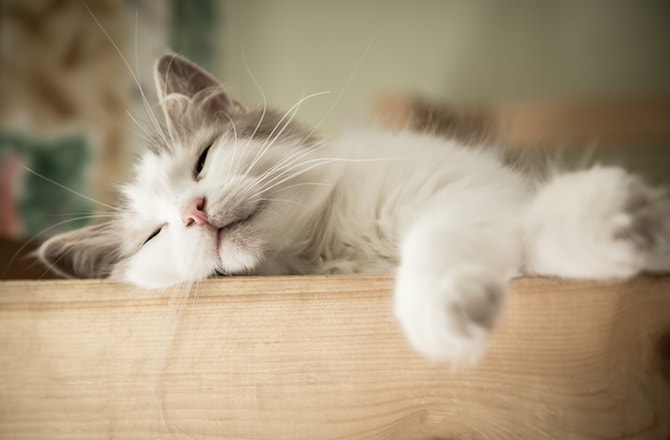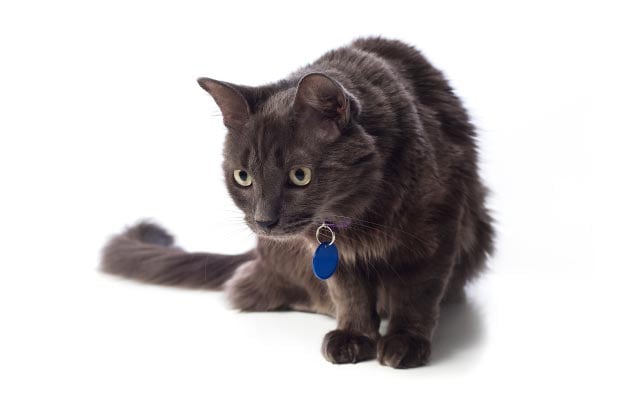If fluff and fur are not your thing, take a closer look at rare, regal and striking hairless cats. Prized for their bearing presence and lack of shedding, hairless cats are a popular feline companion among people seeking a unique pet that’s also sweet and loving. Though the Sphynx is arguably the most popular of the hairless cats, these “bald cats” come in many shapes and sizes. In addition to hairless cat breed overviews, we’re also outlining some important care advice and answering some FAQs. These naked cats do come with a few caveats—including specific grooming requirements and sun care—so make sure to read up before adopting or buying one.
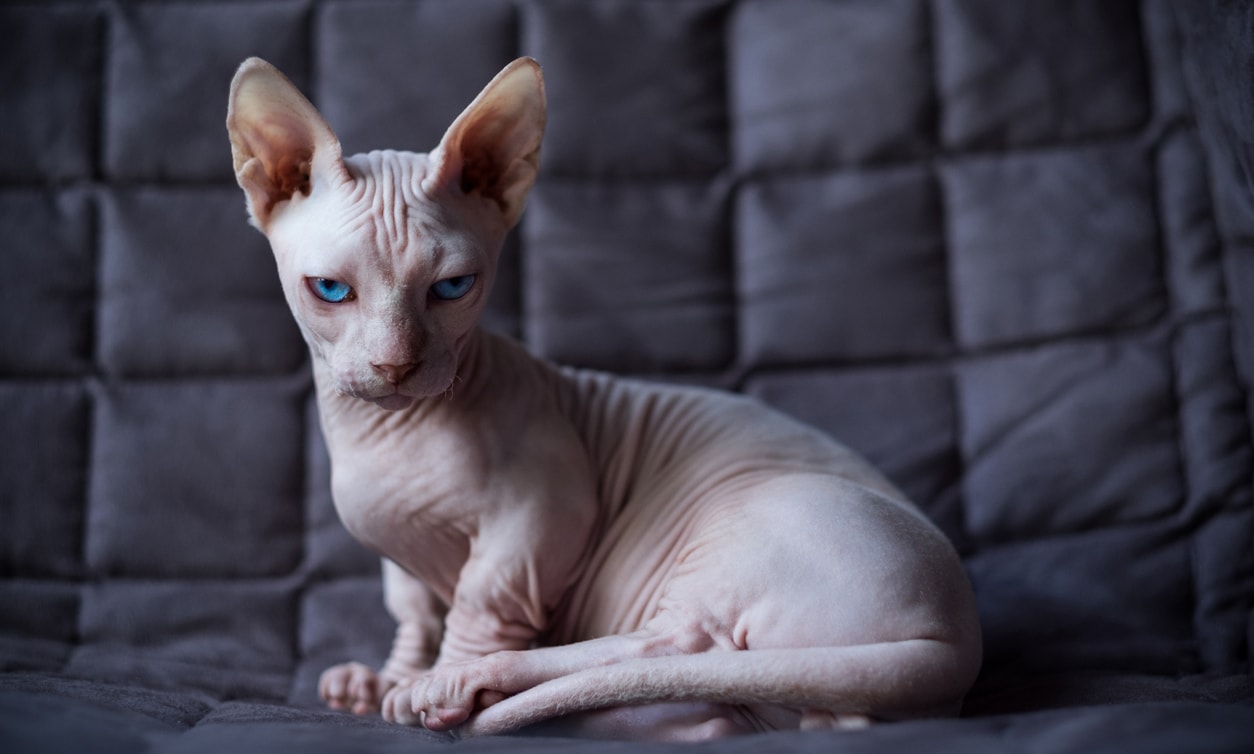
1 | Bambino
A cross between a Sphynx and a Munchkin (a genetically dwarf type of cat), Bambino’s name is apt when you consider its petite size (Bambino is Italian for “baby”). Physically unique with the short legs of a Munchkin, big round eyes and large ears, the Bambino is affectionate, friendly with kids and other pets, and very vocal.
Breed snapshot:
- Average size and weight: 7 to 8 inches, 7 to 9 pounds
- Average life expectancy: About 12 years
- Characteristics: Hairless or light fuzz
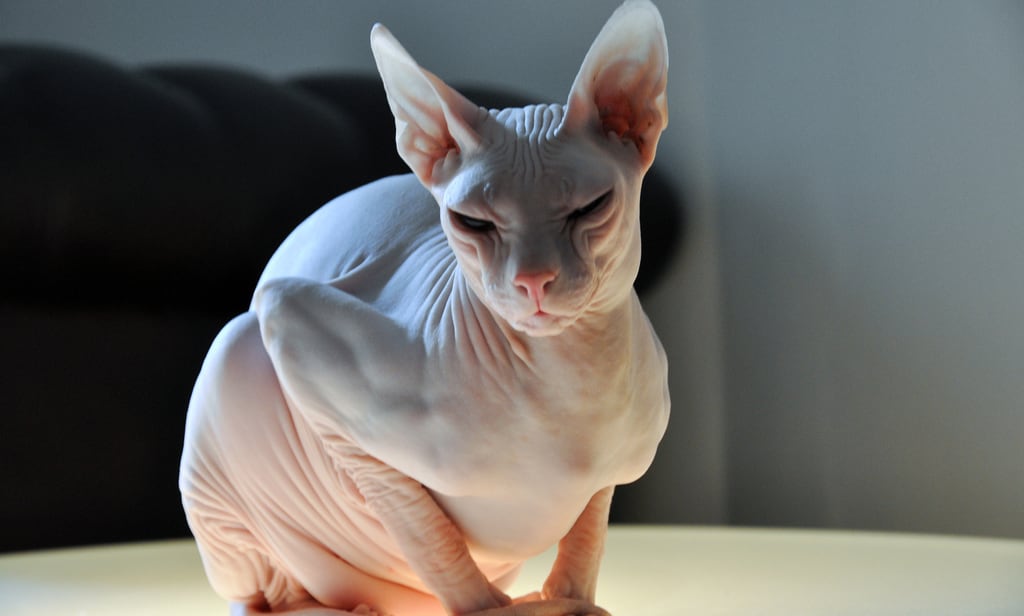
2 | Donskoy
Those eyes! This rare Russian hairless breed goes by a few names including Russian Donskoy, Russian Hairless, Don Sphynx, and Don Hairless. Medium-sized, loyal, loving, affectionate, playful and smart are just a few of the reasons this is a much-loved breed. Fun fact: unlike the sphynx which gets its hairlessness from a recessive genetic mutation, Donskoy gets its hairlessness from a dominant gene.
Breed snapshot:
- Average size and weight: 8 to 12 inches, 7 to 15 pounds
- Average life expectancy: About 12 years
- Characteristics: Hairless, sometimes develops light fuzz in winter
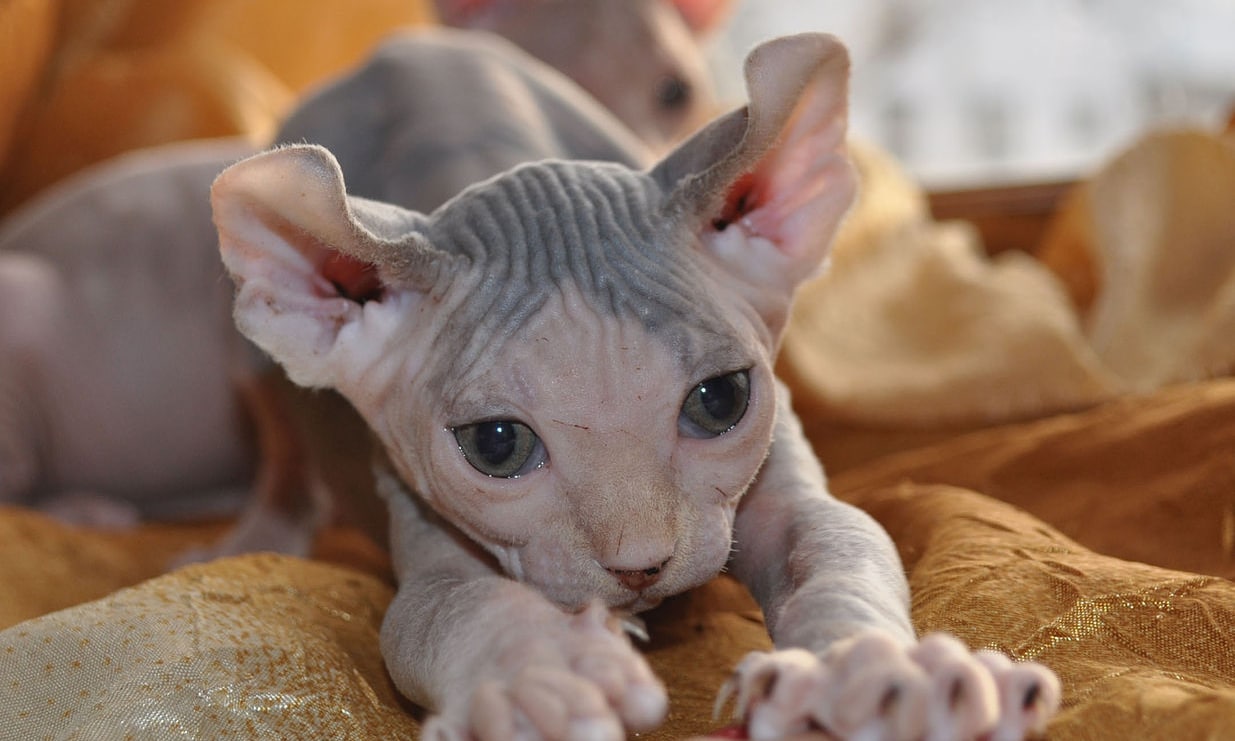
3 | Elf
The Elf is a medium-sized naked cat breed that is quite new and therefore exceptionally rare. It’s a mix between the Sphynx—which is where it gets its baldness—and the American Curl, which is where this breed gets its distinctive curled ears. It’s not completely hairless like the Sphynx, and instead has a fine (sometimes hard to see) coat that resembles peach fuzz. Elfs are highly affectionate and friendly with moderate energy levels and a gentle disposition.
Breed snapshot:
- Average size and weight: 8 to 10 inches, 10 to 15 pounds
- Average life expectancy: About 8 to 14 years
- Characteristics: Hairless, comes in many colors and patterns

4 | Lykoi
Also referred to as a “werewolf cat,” some Lykoi (means "wolves" in Greek) are furry while others are not. Furry varieties have a coat that resembles a wolf, whereas partially hairless ones lack hair on their faces and ears, as well as their legs and feet. In some cases, this breed may lose most of its hair as it ages from kitten to adulthood. It is believed that its hairlessness (or partial hairlessness) is caused by a genetic mutation.
Breed snapshot:
- Average size and weight: 8 to 10 inches, 4 to 7 pounds
- Average life expectancy: About 13 to 15 years
- Characteristics: Small, can be hairless or have a coat
5 | Peterbald
A cross between the Donskoy and an oriental shorthair feline, the Peterbald isn’t always completely hairless. Sometimes it’s born with a typical fur coat, and other times it has a soft, fine, velour-like coat. In some cases, cats born with this downy coat shed it with age. Either way, it has a long body, broad ears and oblong head shape, and it is known for being loyal, friendly and intelligent.
Breed snapshot:
- Average size and weight: 8 to 10 inches, 7 to 14 pounds
- Average life expectancy: About 12 to 15 years
- Characteristics: Small, can be hairless or have a coat
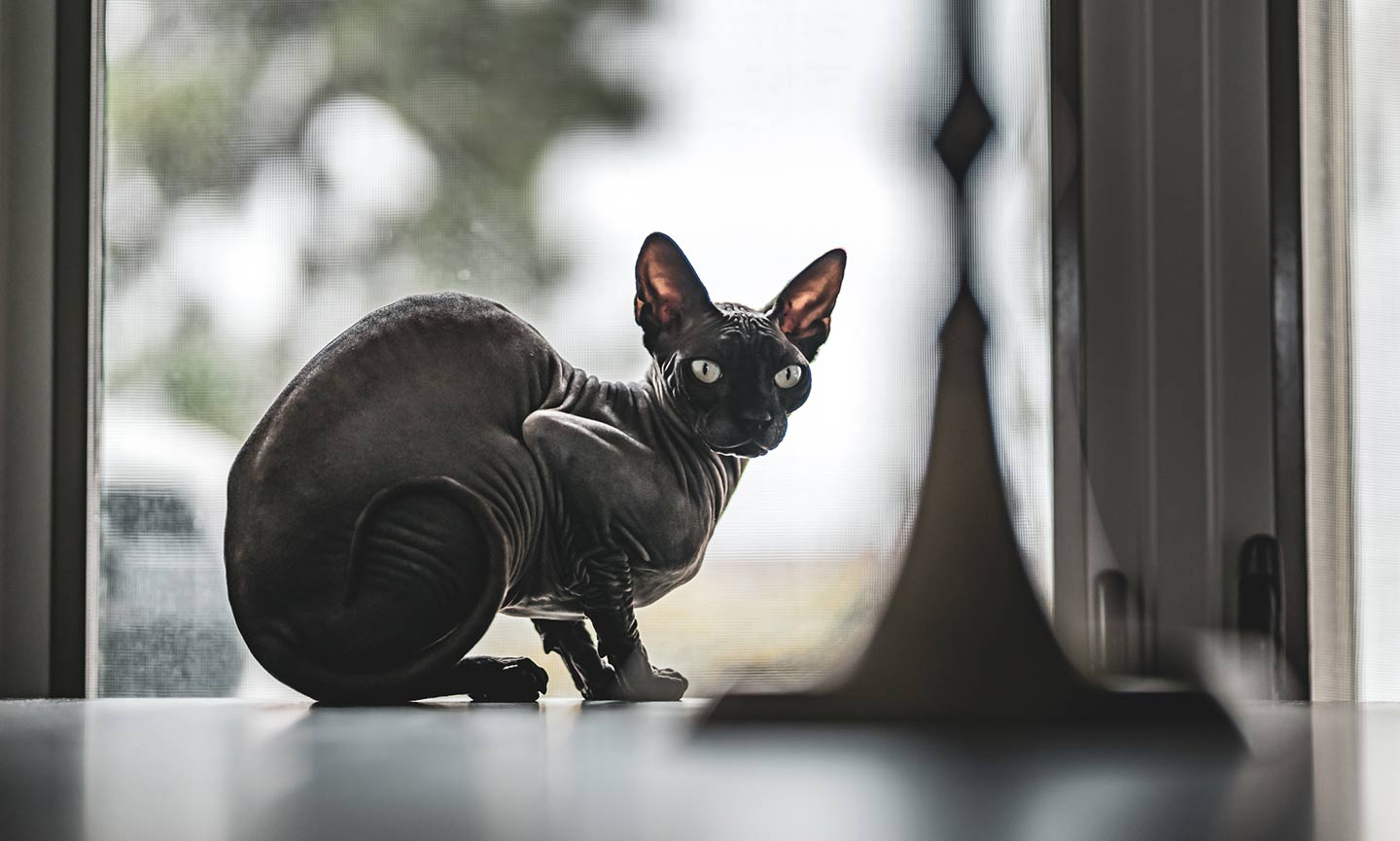
6 | Sphynx
Arguably the most famous of all naked cat breeds, the Sphynx is a beautiful, small to medium feline with a truly regal appearance. It’s believed that its hairlessness is the result of a genetic mutation. All good, but what you will admire is this cat's exceptionally broad, perky ears and striking wide eyes along with a lean, elongated body with prominent wrinkles. It sometimes has small patches of fur but is typically mostly hairless.
Breed snapshot:
- Average size and weight: 8 to 10 inches, 8 to 12 pounds
- Average life expectancy: About 9 to 15 years
- Characteristics: Hairless, wrinkled head, lean body
7 | Ukrainian Levkoy
The Ukrainian Levkoy is currently only recognized by certain Ukrainian and Russian clubs and is exceptionally rare, believed to be a cross between a Donksoy and Scottish Fold. This medium-sized naked cat breed has inward-folding ears and a very muscular, slender body with wide, almond-shaped eyes, a wedge-shaped head, and wrinkled skin. Sometimes it has a soft peach fuzz instead of being completely bald.
Breed snapshot:
- Average size and weight: 7 to 10 inches, 8 to 12 pounds
- Average life expectancy: About 12 to 15 years
- Characteristics: May have peach fuzz, slender build
How to Care for Hairless Cats
While many of the felines we know and love are pretty much “hands off” when it comes to their care, hairless cats require more human help. Naked cat breeds are more prone to developing skin rashes and sunburns, have specific health concerns and tend to get cold easily so extra care is important. We turned to our panel of experts for their best advice on caring for these rare breeds.
Groom and Bathe Often
It’s true that hairless cats shed much less than their furry counterparts, but paradoxically they also require more grooming than other breeds.
- Issues: Oily skin and wax accumulation in ears and around nail beds
- Recommendations: Weekly shampoo or daily cleaning with damp cloth, regular ear cleaning
“In these cats, the oil glands are still present and open directly into rudimentary hair follicles and apocrine ducts open onto the skin surface. This causes their skin to become very greasy or oily,” explains Dr. Dana Varble, chief veterinary officer of the North American Veterinary Community (NAVC).
Dr. Shari Brown, a veterinarian in Chesapeake, VA, recommends using a mild hydrating shampoo on your hairless cat about once per week. You can also wipe them down daily with a soft, warm, damp cloth, making sure to clean between deep wrinkles where oil, dirt and debris can accumulate.
“Also get into a routine of regular ear cleanings to help with the wax build-up,” says Dr. Brown. “Sometimes it can be difficult to determine wax build-up from infection. If other signs are occurring, a consult with a vet should be performed.”
Dr. Varble adds that some of her clients also notice that their hairless cats have black stained teeth, tongues, and toenails. She says this is also caused by an increase in oil on the skin, though sometimes yeast infections are the culprit.
Be on the Lookout for Skin and Health Conditions
Hairless cats and kittens are prone to developing dermatological issues, which is why routine bathing and grooming is so important for these breeds.
- Issue: Plugged hair follicles, infections and skin conditions
- Recommendations: Work with your vet on oral or topical treatment options
“Many hairless cats will develop seborrhea, comedones, [ear infections], and recurrent bacterial and yeast infections,” notes Dr. Varble. “Comedones are dilated, plugged hair follicles. These usually look like dark pimples and are seen commonly on the cat’s chin and body. Sometimes they can be severe and occur over the entire body.”
Your veterinarian can help decide if diagnostic tests and treatment are necessary for these conditions. You should also speak to your veterinarian about special shampoos, topical or oral medications, and even dietary needs for your hairless cat.
In addition to skin conditions such as pimples and rashes, some hairless cat breeds are predisposed to certain health issues. Dr. Varble says Sphynx cats (and their crossbreeds) are prone to heart disease and muscular dystrophy.
Protect Them from the Sun
The very nature of a hairless cat means it doesn’t have a layer of fur to protect it from the elements. For that reason, it’s extra important that you keep this feline safe from the sun’s harmful rays.
- Issues: Potential damage from sunburn
- Recommendations: Limit exposure to sun, use topical sunscreens
“This is a real issue with these cats, and I recommend that they have limited exposure to the sun even when they are indoors,” says Dr. Varble. “The concern with most sunscreens is the cats licking it off, so I believe keeping their sun time limited works best.”
If your cat does have outdoor access, or you find that your cat enjoys basking in the window or sunlight then apply a pet-safe SPF daily, such as Epi-Pet Sun Protector Skin Treatment Spray.
Help Them Stay Warm
“Hairless cats are heat-seeking missiles,” says Maria Drechsel, owner of Fabulous Feline Grooming in Calgary, Canada. “They are constantly looking for a lap to snuggle on or blankets to crawl under.”
- Issues: Lack of fur can lead to loss of body heat
- Recommendations: Create warm spots for them, use cat apparel as needed
She adds that because of their oily skin, hairless cats may stain your blankets and sheets. “Wherever they prefer to curl up, place a blanket or towel there so you can wash it, as their body oils can build up there,” she says.
You can protect your surfaces while keeping your cat warm via pet clothing, as well. Depending on the season or time of day, we recommend having your hairless cat wear a simple t-shirt, cozy pair of pajamas, sweater, or even Thundershirt.
Keep Them Engaged
Many hairless cat breeds have medium to high energy levels, which means they really benefit from physical and mental exercise.
- Issue: A bored cat is trouble waiting to happen
- Recommendation: Provide plenty of stimulation and lots of fun toys
“All the hairless cats I’ve met are very sweet and cuddly, but also active. They want to play and have cat interactive toys, but also will seek out warmth from the owners,” notes Lynn Paolillo, a certified instructor with the National Cat Groomers Institute of America, Inc.
Hairless Cats FAQs
Q: Are hairless cats hypoallergenic?
A: Not always. While mostly fur-free, hairless cats are not always hypoallergenic. In addition to their dander, cat allergies in people can be caused by the proteins in a cat’s urine and saliva—specifically the Fel d 1 protein. As a result, hairless cat breeds, such as the Peterbald, may still elicit allergies in people that encounter them. Weekly bathing can help.
Q: Do hairless cats have dander?
A: Yes, hairless cats do have dander. If you are allergic to cat dander, then you will likely experience that same allergic reaction whether a cat is with or without fur.
Q: Where do hairless cats come from?
A: It’s believed that many hairless cats originated from the Aztec cat, a now-extinct ancient cat that did not have any fur. There’s also a line of hairless cats that are believed to have originated in Canada. The hairless cat breeds recognized today are relatively new and still quite rare.
Q: Do hairless cats have whiskers?
A: Yes and no. Some hairless cats do have whiskers, while others do not. In cases where whiskers are present, they are sometimes short and stubby, or they can wind up broken.
Q: Are hairless cats “natural"?
A: The answer to whether hairless cats are natural depends on your definition. As with all dogs and cats, hairless cat breeds have been developed through a process of selective breeding. Generally speaking, their hairlessness is technically a naturally occurring genetic mutation.
We hope this comprehensive overview on hairless cats helps inform your decision to own and care for these regal felines. When in doubt, consult your veterinarian about any questions that may come up.
If you suspect your pet is sick, please call your vet immediately. For health-related questions, always consult your regular veterinarian when possible as they can make the best recommendations for your pet. (If you need help finding a vet near you use this link.)
Share:




